Introduction
Stir-fried Chinese cabbage with dried tofu, or bai cai chao gan dou fu in Mandarin, is a beloved staple in Chinese home cooking. This humble dish combines the crisp freshness of Chinese cabbage with the chewy, porous texture of dried tofu, all harmonized by a savory sauce that elevates the ingredients to new heights. Despite its simplicity, this recipe requires precision in technique and balance in flavor to achieve the perfect interplay of textures and tastes. Whether you’re a novice cook or a seasoned home chef, mastering this dish will reward you with a versatile, nutritious meal that pairs beautifully with rice, noodles, or congee. In this comprehensive guide, we’ll explore the history of this dish, its cultural significance, and the step-by-step process to recreate it authentically in your kitchen.
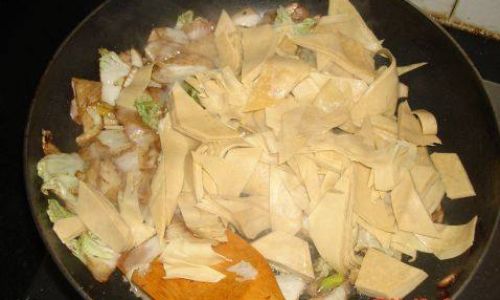
The Cultural Significance of Stir-Fried Cabbage and Dried Tofu
Chinese cabbage, known as da bai cai (大白菜), has been cultivated in China for over 1,500 years. Its mild, slightly sweet flavor and crunchy leaves make it a kitchen workhorse, appearing in soups, dumplings, and stir-fries. Dried tofu, or gan dou fu (干豆腐), is a preserved form of tofu that has been pressed and dried to remove moisture, resulting in a dense, chewy texture that absorbs flavors exceptionally well. Together, these ingredients form a marriage of simplicity and depth—a testament to the Chinese culinary philosophy of hao chi bu ruan (好吃不厌), or “delicious without being fussy.”
This dish’s popularity stems from its accessibility. Chinese cabbage and dried tofu are inexpensive, shelf-stable, and widely available, making them a go-to for budget-conscious families. Yet, the dish’s humble origins belie its culinary sophistication. Achieving the ideal balance of crisp cabbage, tender tofu, and a glossy sauce requires attention to detail, from slicing the vegetables uniformly to controlling the heat during stir-frying.
Ingredients: Building Flavor Layer by Layer
To create an authentic stir-fried Chinese cabbage with dried tofu, gather the following ingredients:
- Chinese Cabbage (Napa Cabbage): 1 medium head (about 1.5 pounds). Look for crisp, pale green leaves with firm white stalks. Avoid wilted or yellowing specimens.
- Dried Tofu: 4–5 sheets (approximately 6 ounces). Opt for thin, lightly salted varieties for optimal texture.
- Aromatics:
- Fresh garlic: 3 cloves, minced
- Ginger: 1-inch piece, grated
- Scallions: 2 stalks, thinly sliced (white and green parts separated)
- Sauce Base:
- Light soy sauce: 2 tablespoons
- Oyster sauce: 1 tablespoon (or vegetarian oyster sauce for a vegan version)
- Shaoxing wine: 1 teaspoon (optional, but adds depth)
- Sesame oil: 1/2 teaspoon
- Sugar: 1/4 teaspoon (to balance bitterness)
- White pepper: 1/4 teaspoon
- Thickening Agent:
- Cornstarch: 1 teaspoon
- Water: 2 tablespoons (to dissolve cornstarch)
- Cooking Oil:
Peanut oil or vegetable oil: 2 tablespoons (high smoke point oils work best for stir-frying)
- Optional Additions:
- Dried chili flakes: 1/2 teaspoon (for heat)
- Black fungus: 1/4 cup (rehydrated, for added texture)
- Shaoxing vinegar: 1/2 teaspoon (for a tangy finish)
Preparation: The Foundation of Flavor
- Prepping the Chinese Cabbage:
- Separate the leaves from the core. Rinse each leaf under cold water, paying special attention to the crevices where dirt may hide.
- Slice the cabbage crosswise into 1-inch strips. Separate the white stalks from the green leaves, as they require different cooking times.
- Preparing the Dried Tofu:
- Rinse the dried tofu sheets under warm water to remove excess salt. Pat dry with paper towels.
- Stack the sheets and cut them into 1/4-inch-wide strips. For added texture, lightly toast the strips in a dry pan until golden before stir-frying.
- Mise en Place:
- Mince the garlic and ginger. Slice the scallions, keeping the white and green parts separate.
- Combine the sauce ingredients (soy sauce, oyster sauce, Shaoxing wine, sesame oil, sugar, white pepper) in a small bowl. Mix the cornstarch and water in another bowl to create a slurry.
Cooking Technique: The Dance of the Wok
Stir-frying is a high-heat, rapid-cooking method that requires focus and timing. Follow these steps for perfection:
- Heating the Wok:
- Place your wok or large skillet over high heat. Allow it to smoke lightly—this ensures the ingredients sear rather than steam.
- Add 2 tablespoons of oil and swirl to coat the pan. The oil should shimmer but not smoke.
- Stir-Frying the Aromatics:
Add the garlic, ginger, and white parts of the scallions. Stir-fry for 10–15 seconds until fragrant but not browned. Overcooking aromatics will introduce bitterness.
- Cooking the Dried Tofu:
Toss in the dried tofu strips. Stir-fry for 2–3 minutes until they develop a slight golden hue. The porous texture will absorb the aromatics’ flavors.
- Adding the Cabbage Stalks:
Introduce the white cabbage stalks first, as they take longer to cook. Stir-fry for 2 minutes, tossing vigorously to coat them in oil and sauce.
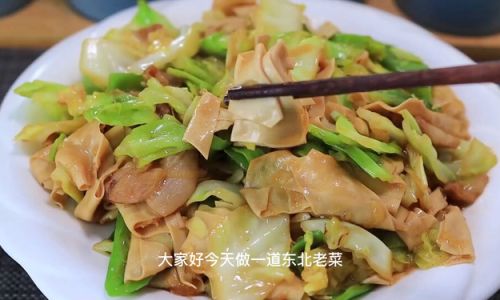
- Incorporating the Cabbage Leaves:
Add the green cabbage leaves and black fungus (if using). Continue stir-frying for 3–4 minutes until the leaves wilt but retain their vibrant color. Avoid overcooking, which leads to mushiness.
- Deglazing and Thickening:
- Pour in the sauce mixture, stirring to coat the ingredients. Allow it to bubble for 30 seconds.
- Drizzle in the cornstarch slurry while stirring. The sauce will thicken into a glossy glaze within 1 minute.
- Finishing Touches:
Remove the wok from heat. Stir in the scallion greens and a drizzle of sesame oil. Taste and adjust seasoning with a pinch of salt or sugar if needed.
Serving Suggestions and Pairings
This dish shines when paired with steamed jasmine rice, which soaks up the savory sauce beautifully. For a heartier meal, serve it alongside:
- Fried Rice: The contrasting textures of the stir-fry and rice create a satisfying meal.
- Congee: The dish’s mild flavors complement the porridge’s comforting blandness.
- Pan-Fried Dumplings: The crispy dumplings and tender stir-fry offer a delightful textural play.
Variations and Customizations
One of the joys of this recipe is its adaptability. Experiment with:
- Protein Boost: Add 4 ounces of ground pork, chicken, or shrimp. Marinate the meat in 1 teaspoon of soy sauce and 1/2 teaspoon of cornstarch before cooking.
- Spicy Kick: Toss in dried chili flakes or a sliced Fresno pepper during the aromatics stage.
- Vegetarian Twist: Substitute the oyster sauce with mushroom-flavored soy sauce or hoisin sauce.
- Umami Depth: Include a teaspoon of fermented black bean paste or doubanjiang for a savory punch.
Troubleshooting Common Pitfalls
- Soggy Cabbage: Overcooking is the culprit. Stir-fry the leaves until just wilted to retain their crunch.
- Bland Flavor: Ensure the sauce is well-seasoned and the dried tofu is adequately toasted to absorb flavors.
- Burnt Aromatics: Cook garlic and ginger over medium heat if your stove runs hot, or add a splash of oil to prevent scorching.
The Science Behind the Stir-Fry
Stir-frying at high heat (350–400°F) triggers the Maillard reaction, creating complex flavors in the cabbage and tofu. The quick cooking time preserves the vegetables’ nutrients, particularly vitamin C and folate, which are heat-sensitive. Dried tofu’s porous structure acts as a flavor sponge, absorbing the sauce’s umami notes while providing plant-based protein.
Health Benefits: A Nutritional Powerhouse
- Chinese Cabbage: Rich in fiber, vitamins K, A, and C, and antioxidants that support immune function and bone health.
- Dried Tofu: A low-calorie source of plant protein (10g per 3.5 ounces) and calcium, ideal for vegans and vegetarians.
- Garlic and Ginger: Contain allicin and gingerol, compounds linked to anti-inflammatory and anti-viral properties.
Conclusion: The Joy of Simplicity
Stir-fried Chinese cabbage with dried tofu is more than a meal—it’s a lesson in culinary restraint. By honoring the ingredients’ natural flavors and mastering the stir-fry technique, you create a dish that’s both comforting and elegant. Whether served on a busy weeknight or as part of a festive banquet, this recipe embodies the essence of Chinese home cooking: nourishing, humble, and deeply satisfying. So grab your wok, heat the oil, and let the sizzle of the stir-fry transport you to the heart of a Chinese kitchen.
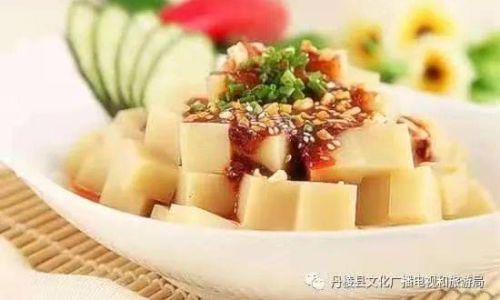

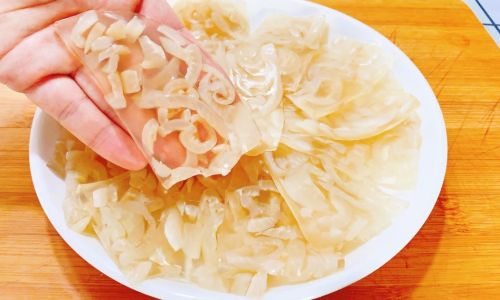
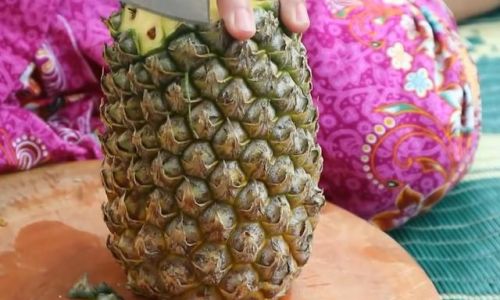
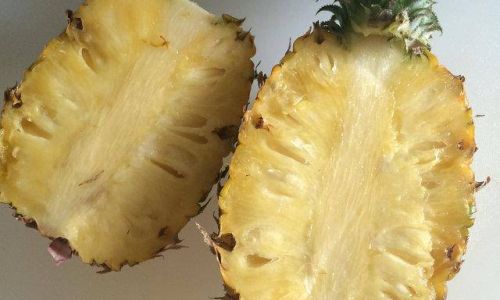

0 comments